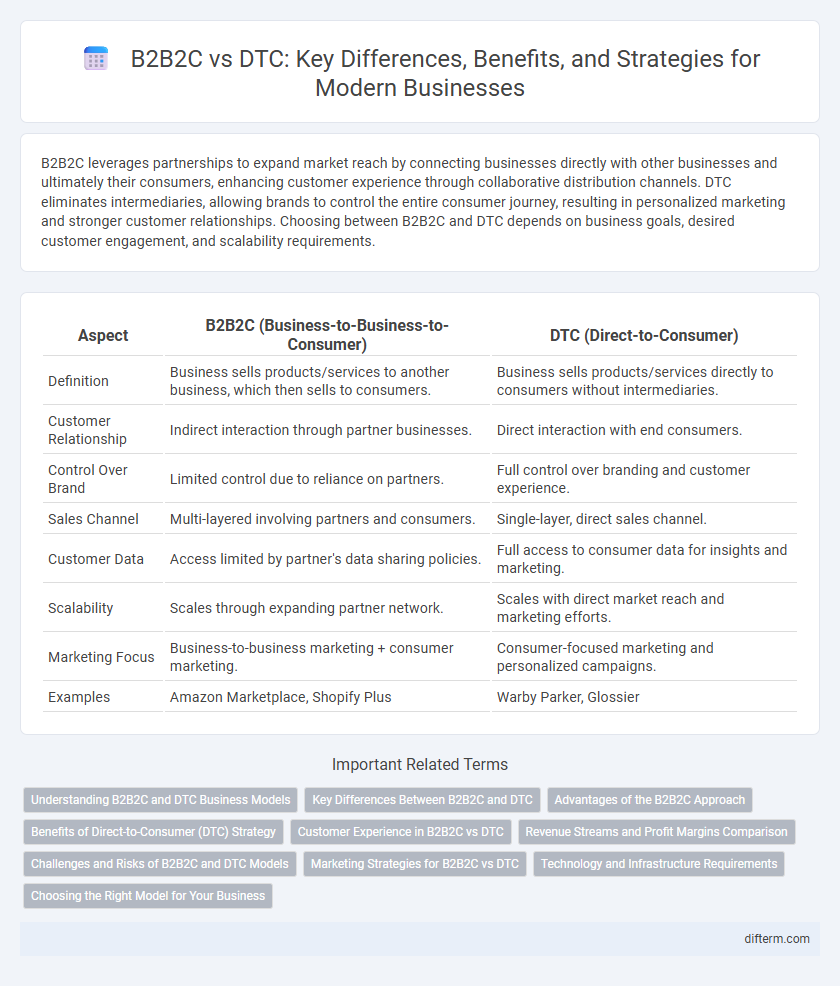B2B2C leverages partnerships to expand market reach by connecting businesses directly with other businesses and ultimately their consumers, enhancing customer experience through collaborative distribution channels. DTC eliminates intermediaries, allowing brands to control the entire consumer journey, resulting in personalized marketing and stronger customer relationships. Choosing between B2B2C and DTC depends on business goals, desired customer engagement, and scalability requirements.
Table of Comparison
| Aspect | B2B2C (Business-to-Business-to-Consumer) | DTC (Direct-to-Consumer) |
|---|---|---|
| Definition | Business sells products/services to another business, which then sells to consumers. | Business sells products/services directly to consumers without intermediaries. |
| Customer Relationship | Indirect interaction through partner businesses. | Direct interaction with end consumers. |
| Control Over Brand | Limited control due to reliance on partners. | Full control over branding and customer experience. |
| Sales Channel | Multi-layered involving partners and consumers. | Single-layer, direct sales channel. |
| Customer Data | Access limited by partner's data sharing policies. | Full access to consumer data for insights and marketing. |
| Scalability | Scales through expanding partner network. | Scales with direct market reach and marketing efforts. |
| Marketing Focus | Business-to-business marketing + consumer marketing. | Consumer-focused marketing and personalized campaigns. |
| Examples | Amazon Marketplace, Shopify Plus | Warby Parker, Glossier |
Understanding B2B2C and DTC Business Models
B2B2C (Business-to-Business-to-Consumer) integrates intermediary businesses to reach end consumers, enabling expanded market access and shared customer insights. DTC (Direct-to-Consumer) eliminates middlemen by selling products directly to customers, enhancing brand control and personalized customer experiences. Understanding these models is crucial for businesses to optimize distribution strategies and maximize customer engagement effectively.
Key Differences Between B2B2C and DTC
B2B2C involves businesses selling products or services through intermediaries to reach end consumers, creating a multi-layered supply chain that leverages partner networks for market expansion. In contrast, DTC (Direct-to-Consumer) brands sell directly to customers, allowing full control over customer experience, pricing, and data analytics. Key differences include distribution channels, customer relationship management, and brand control, where B2B2C emphasizes collaboration and scale, while DTC focuses on direct engagement and higher margins.
Advantages of the B2B2C Approach
The B2B2C approach enables businesses to leverage established distribution networks and customer bases, accelerating market penetration and reducing acquisition costs. It facilitates personalized customer experiences through data-sharing partnerships between businesses and end consumers, enhancing retention and satisfaction. This model also offers scalability by combining B2B operational efficiencies with direct consumer insights, optimizing revenue streams across multiple touchpoints.
Benefits of Direct-to-Consumer (DTC) Strategy
Direct-to-Consumer (DTC) strategy empowers businesses to build stronger customer relationships by collecting first-party data and personalizing marketing efforts, enhancing customer loyalty and lifetime value. DTC models eliminate intermediaries, increasing profit margins and enabling greater control over brand messaging and product experience. Access to real-time consumer insights allows companies to rapidly adapt product offerings and improve customer satisfaction, driving sustainable revenue growth.
Customer Experience in B2B2C vs DTC
B2B2C models often enhance customer experience by leveraging partner networks to provide personalized and scalable solutions, ensuring seamless integration across multiple touchpoints. DTC businesses, on the other hand, prioritize direct relationships with consumers, enabling faster feedback loops and tailored brand interactions that boost loyalty and satisfaction. Both models emphasize user-centric approaches, but B2B2C relies on collaboration for broader reach, while DTC focuses on controlling the entire customer journey.
Revenue Streams and Profit Margins Comparison
B2B2C models generate diversified revenue streams by leveraging partnerships between businesses, often resulting in moderate profit margins due to shared revenue with intermediaries. DTC approaches capture full revenue from end consumers, enabling higher profit margins by eliminating third-party costs and controlling pricing strategies. Businesses prioritizing rapid scalability may prefer B2B2C, while brands seeking maximum profitability often favor DTC channels.
Challenges and Risks of B2B2C and DTC Models
B2B2C models face challenges such as complex coordination between businesses and end consumers, increased dependency on partner reliability, and difficulties in managing consistent customer experiences across multiple touchpoints. DTC models risk high upfront investment in marketing and logistics, potential channel conflict with retailers, and challenges in scaling customer acquisition sustainably. Both models require strategic risk management to balance operational complexity, cost efficiency, and brand control.
Marketing Strategies for B2B2C vs DTC
B2B2C marketing strategies prioritize collaborative partnerships and co-branding efforts to leverage the strengths of both business clients and end consumers, enhancing distribution channels and customer trust. DTC marketing focuses on direct engagement with consumers through personalized content, data-driven campaigns, and owning customer experience to build brand loyalty and maximize lifetime value. Effective B2B2C approaches integrate partner incentives and multi-touch attribution models, while DTC relies heavily on social media advertising, influencer partnerships, and first-party data analytics.
Technology and Infrastructure Requirements
B2B2C business models require robust integration platforms to connect multiple stakeholders, ensuring seamless data exchange and customer experience management across partners. DTC brands prioritize scalable e-commerce infrastructure with direct customer relationship management systems, emphasizing personalized marketing and agile fulfillment capabilities. Both models demand advanced cybersecurity measures and cloud-based solutions to support real-time analytics and operational efficiency.
Choosing the Right Model for Your Business
Selecting the optimal business model between B2B2C and DTC depends on target market reach, control over customer experience, and cost structure. B2B2C offers scalability and access to established customer bases through partnerships, while DTC enables direct customer relationships and higher margins. Businesses must evaluate brand control priorities and resource allocation to determine the most effective approach for growth and profitability.
B2B2C vs DTC Infographic

 difterm.com
difterm.com